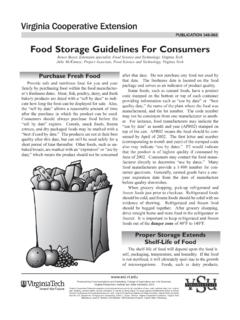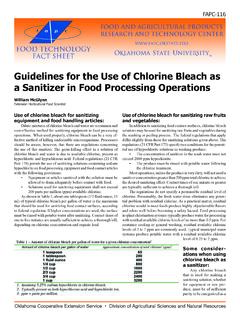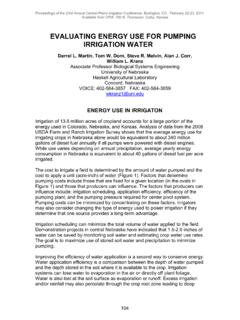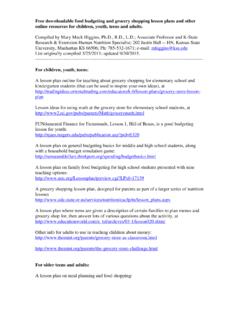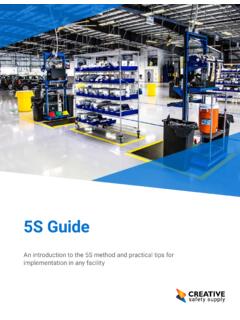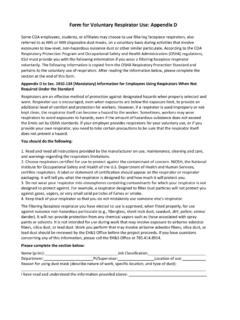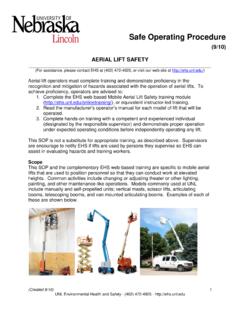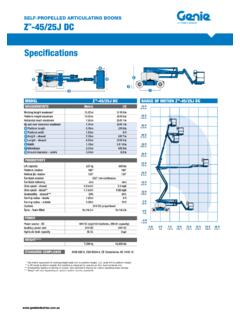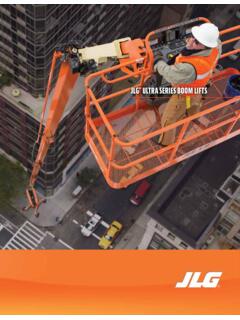Transcription of Standards of Practice Aerial Lift Operations
1 Page - 1 - of 7 Standards of Practice Aerial Lift Operations I. PURPOSE To reduce the risk of physical injury or property damage in areas where Aerial lifts are in operation. II. SCOPE This procedure covers Aerial lift Operations that KSU s College of Agriculture can control and over which it can be expected to have an influence. These activities include, but are not limited to training, inspections, and the safe operation of the equipment. III. CONSEQUENCES OF DEVIATION This procedure serves as an essential element in identifying and managing risk to staff associated with Aerial lift activities. Ignoring this procedure could result in serious injuries, fatalities, or property damage. IV. DEFINITIONS Aerial lifts are vehicle-mounted, boom -supported Aerial platforms, such as cherry pickers or bucket trucks, used to access utility lines and other aboveground job sites.
2 The major causes of fatalities are falls, electrocutions, and collapses or tip overs. Employers must take measures to ensure the safe use of Aerial lifts by their workers if they are required to use this equipment in the course of their employment. V. PRE-INSPECTION Prior to the operation of any Aerial lift the Pre-Use Inspection Checklist found in Appendix A must be completed. This applies at the beginning of every work period, and whenever a new equipment operator takes control of the Aerial lift. Any safety defects (such as hydraulic fluid leaks; defective brakes, steering, lights, or horn; and/or missing fire extinguisher, lights, seat belt, or back-up alarm) must be reported for immediate repair. They must also be locked and tagged, and taken out of service. VI.
3 GENERAL SAFE WORK PRACTICES Operators shall not wear any loose clothing or any accessory that can catch in moving parts. Before machine is started, the operator must walk completely around the machine to ensure everyone and everything is clear of the machine. articulating boom and extendable boom platforms, primarily designed as personnel carriers, shall have both platform (upper) and lower controls. Upper controls shall be in or beside the platform within easy reach of the operator. Lower controls shall provide for overriding the upper Document Authority: EH&S Coordinator Document Custodian: EH&S Coordinator Effective Date: Issuing Dept: College of Agriculture EH&S Next Review Date: Control Tier: II Document Number: AL001 Page - 2 - of 7 controls. Controls shall be plainly marked as to their function.
4 Lower level controls shall not be operated unless permission has been obtained from the employee in the lift, except in case of emergency. Modifications and additions that may affect the capacity or safe operation of an Aerial /scissor lift are strictly prohibited without the manufacturer s written approval. Capacity, operation, and maintenance instruction markings will be changed as necessary if the manufacturer approves a modification. The insulated portion (if applicable) of an Aerial / scissor lift shall not be altered in any manner that might reduce its insulating value. Any signs, plates, or decals which are missing or illegible must be replaced. If the Aerial / scissor lift becomes disabled, a out of service tag or equivalent shall be attached to the controls inside the platform in a conspicuous location.
5 Aerial /scissor lift devices with noted, reported deficiencies shall not be operated until repairs are made and equipment is authorized for use. Operators must report all accidents, regardless of fault and severity, to their Supervisor. VII. SAFE WORK PRACTICES BEFORE OPERATION Consideration shall be given to the amount of wind. Follow the manufacturer s instruction regarding operation in windy conditions. As a general rule Aerial lifts shall not be operated in winds exceeding 25mph although this can vary depending on the model of equipment o At 20mph wind speeds or anticipated gusts, lifts will be lowered to a maximum height of 20 feet. o At 25mph wind speeds or anticipated gusts, lifts will be grounded. o If at any time, video personnel/staff feels unsafe in lifts, they may make decision to ground the lifts and cease with videotaping games or questions asked.
6 Guardrails must be installed and access gates or openings must be closed before raising the platform. boom and platform load limits specified by the manufacturer shall not be exceeded. Before moving an Aerial lift for travel, the boom (s) shall be inspected to see that it is properly cradled and outriggers are in stowed position (if equipped). Consideration shall be given to the protection of bystanders via barricading, having another employee keep bystanders at a safe distance or by other means. Aerial lifts shall not be operated from trucks, scaffolds, or similar equipment. VIII. SAFE WORK PRACTICES DURING OPERATION Attention shall be given towards the direction of travel, clearances above, below and on all sides. Employees shall not sit or climb on the guardrails of the Aerial lift.
7 Planks, ladders or other devices shall not be used on the work platform. An Aerial lift shall not be moved when the boom is elevated in a working position with employees in the basket. Aerial lift shall not be placed against another object to steady the elevated platform. Aerial lift shall not be used as a crane or other lifting device. Aerial lift devices shall not be operated on grades, side slopes or ramps that exceed the manufacturer's recommendations. The brakes shall be set and outriggers, when used, shall be positioned on pads or a solid surface. Page - 3 - of 7 Speed of Aerial lift devices shall be limited according to the conditions of the ground surface, congestion, visibility, slope, location of personnel and other factors that may cause hazards to other nearby personnel.
8 Stunt driving and horseplay shall not be permitted. Booms and elevated platform devices shall not be positioned in an attempt to jack the wheels off the ground. The area surrounding the elevated platform shall be cleared of personnel and equipment prior to lowering the elevated platform. All equipment must be secured on the inside of the Aerial lift Operators are to call for assistance if the platform or any part of the machine IX. SAFE WORK PRACTICES AFTER OPERATION Safe shutdown shall be achieved by utilizing a suitable parking area, placing the platform in the stowed position, placing controls in neutral, idling engine for gradual cooling, turning off electrical power, and taking the necessary steps to prevent unauthorized use. Aerial lifts shall be shut off prior to fueling.
9 Fueling must be completed in well ventilated areas free of flames, sparks or other hazards which may cause fires or explosions. X. TRAINING Employees who are authorized to operate Aerial lifts must receive training prior to engaging in their duties, and at least every three (3) years thereafter. The training is to ensure that the Aerial Lift Safety is understood. The supervisor will also ensure that authorized Aerial lift operators have acquired the necessary practical skills required for safe operation. Training is offered by the EH&S Office, Rental Company and the department in possession of the lift. The department along with the rental company will perform an operational training with each employee to determine if operators have the knowledge, training, and skills necessary to use the Aerial lift.
10 Operational training will consist of a combination of general safety instruction, practical/operational training (demonstrations performed by the trainer, and practical exercises performed by the trainee), and evaluation of the operator's performance in the workplace. All operational training must be conducted under close supervision. Each department must maintain a record of all individual training, including: Subject of training Date of training Name of individual trained Name of supervisor or Occupational Health and Safety person providing the training, and Training records must maintained by the department for a minimum of 3 years. XI. OHSA SAFE WORK PRACTCES Make sure that workers who operate Aerial lifts are properly trained in the safe use of the equipment.
